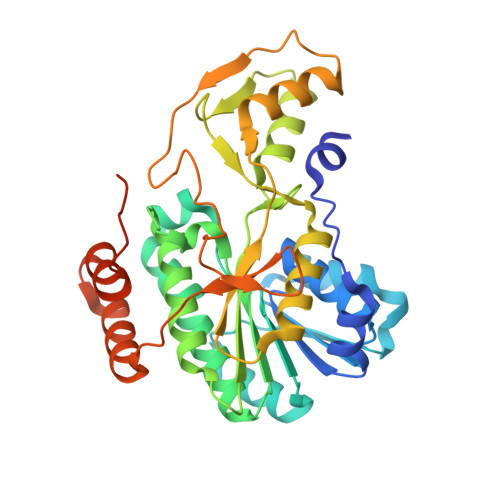Structural and Biochemical Investigation of PglF from Campylobacter jejuni Reveals a New Mechanism for a Member of the Short Chain Dehydrogenase/Reductase Superfamily.
Riegert, A.S., Thoden, J.B., Schoenhofen, I.C., Watson, D.C., Young, N.M., Tipton, P.A., Holden, H.M.(2017) Biochemistry 56: 6030-6040
- PubMed: 29053280
- DOI: https://doi.org/10.1021/acs.biochem.7b00910
- Primary Citation of Related Structures:
5BJU, 5BJV, 5BJW, 5BJX, 5BJY - PubMed Abstract:
Within recent years it has become apparent that protein glycosylation is not limited to eukaryotes. Indeed, in Campylobacter jejuni, a Gram-negative bacterium, more than 60 of its proteins are known to be glycosylated. One of the sugars found in such glycosylated proteins is 2,4-diacetamido-2,4,6-trideoxy-α-d-glucopyranose, hereafter referred to as QuiNAc4NAc. The pathway for its biosynthesis, initiating with UDP-GlcNAc, requires three enzymes referred to as PglF, PglE, and PlgD. The focus of this investigation is on PglF, an NAD + -dependent sugar 4,6-dehydratase known to belong to the short chain dehydrogenase/reductase (SDR) superfamily. Specifically, PglF catalyzes the first step in the pathway, namely, the dehydration of UDP-GlcNAc to UDP-2-acetamido-2,6-dideoxy-α-d-xylo-hexos-4-ulose. Most members of the SDR superfamily contain a characteristic signature sequence of YXXXK where the conserved tyrosine functions as a catalytic acid or a base. Strikingly, in PglF, this residue is a methionine. Here we describe a detailed structural and functional investigation of PglF from C. jejuni. For this investigation five X-ray structures were determined to resolutions of 2.0 Å or better. In addition, kinetic analyses of the wild-type and site-directed variants were performed. On the basis of the data reported herein, a new catalytic mechanism for a SDR superfamily member is proposed that does not require the typically conserved tyrosine residue.
Organizational Affiliation:
Department of Biochemistry, University of Wisconsin , Madison, Wisconsin 53706, United States.


















